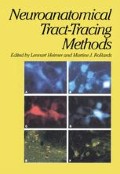Abstract
A full account of the history of the Golgi method has not been written. In his Recollections of My Life, Ramón y Cajal (1937) tersely summarized the discovery of this method when he wrote: “It was discovered by C. Golgi, the famous histologist of Pavia, through the favor of chance, the muse who inspires great discoveries.” A bit more detail is given in a brief passage in Retzius’ autobiographical reflections (Ramón-Moliner, 1970). According to Retzius, Golgi was investigating the pial covering of the brain and studied sections of brains that had been hardened in potassium dichromate and subsequently put in a solution of silver nitrate. Golgi’s genius consisted in the fact that, at a time when knowledge about neuronal structure was very imperfect, he recognized nerve cells in his preparations.
Access this chapter
Tax calculation will be finalised at checkout
Purchases are for personal use only
Preview
Unable to display preview. Download preview PDF.
References
Braitenberg, V., Guglielmotti, V., and Sada, E., 1967, Correlations of crystal growth with the staining of axons by the Golgi procedure, Stain TechnoL 42: 277–283.
Chan-Palay, V., 1973, A brief note on the chemical nature of the precipitate within nerve fibers after the rapid Golgi reaction: Selected area diffraction in high voltage electron microscopy, Z. Anat. Entwickl–Gesch. 139: 115–117.
Colonnier, M., 1964, The tangential organization of the visual cortex, J. Anat. 98: 327–344.
Cox, W., 1891, Impregnation des centralen Nervensystems mit Quecksilber salzen, Arch. Mikr. Anat. 37: 16–21.
Fox, C. A., Ubeda-Purkiss, M., Ihrig, H. K., and Biagioli, D., 1951, Zinc Chromate modification of the Golgi technic. Stain. TechnoL 26: 109–114.
Fregerslev, S., Blackstad, T. W., Fredens, K., and Holm, M. J., 1971, Golgi potassium-dichromate silver nitrate impregnation. Nature of the precipitate studied by X-ray power diffraction methods, Histochemie 25: 63–71.
Geisert, E. E., Jr., and Updyke, B., 1977, Chemical stabilization of Golgi silver Chromate impregnations, TechnoL 52: 137–246.
Golgi, G., 1873, Sulla struttura della sostanza grigia dell cervello, Gass. Med. Ital Lombarda 33: 244–246.
Golgi, G., 1879, Di una nuova reasione apparentemente nera dell cellule nervose cerebrali ottenuta col bichloruro di mercurio. Arch. Sci. Med. 3: 1–7.
Ha, H., 1966, A modified Golgi-Gox method with counterstain for the study of synapses, Anat. Rec. 155: 59–64.
Klatzo, I., 1952, A study of glia by the Golgi method, Lab. Invest. 1:345–350.
Kopsch, F., 1896, Erfahrungen über die Verwendung des Formaldehyds bei der Ghromsilber-imprägnation, Anz. 11: 727–729.
Lee, A. B., 1950, The Microtomist’s Vade-Mecum, llth ed. (J. B. Gatenby and H. W. Beams, eds.), Blakiston, Philadelphia.
Morest, D. K., 1968, The collateral system of the medial nucleus of the trapezoid body of the cat, its neuronal architecture and relation to the olivo-cochlear bundle. Brain Res. 9:288– 311.
Morest, D. K., and Morest, R. R., 1966, Perfusion-fixation of the brain with chrome–osmium solutions for the rapid Golgi method, Am. J. Anat. 118: 811–832.
Palay, S. L., and Chan-Palay, V., 1974, Cerebellar Cortex: Cytology and Organization, Springer-Verlag, New York.
Ramón y Gajal, S., 1937, Recollections of My Life (E. H. Graigie, trans.), MIT Press, Cambridge.
Ramón y Cajal, S., 1960, Studies on Vertebrate Neurogenesis (L. Guth, trans.), Charles C Thomas, Springfield, Illinois.
Ramón y Cajal, S., and DeCastro, F., 1933, Elementos de Tecnica Micrografica del Sistema Nervioso, Tipografia Artistica, Madrid.
Ramóon-Moliner, E., 1957, A chlorate-formaldehyde modification of the Golgi method, Stain Technol. 32: 105–116.
Ramón-Moliner, E., 1970, The Golgi-Cox technique, in: Contemporary Research Methods in Neuroanatomy ( W. J. H. Nauta and S. O. E. Ebbesson, eds.), pp. 32–55, Springer-Verlag, New York.
Scheibel, M. E., and Scheibel, A. B., 1955, The inferior olive. A Golgi study, J. Comp. Neurol. 102: 77–131.
Scheibel, M. E., and Scheibel, A. B., 1970, The rapid Golgi method. Indian summer or renaissance? in: Contemporary Research Methods in Neuroanatomy ( W. J. H. Nauta and S. O. E. Ebbesson, eds.), pp. 1–11, Springer-Verlag, New York.
Scheibel, M. E., and Scheibel, A. B., 1978, The methods of Golgi, in: Neuroanatomical Research Techniques ( R. T. Robertson, ed.), pp. 89–114, Academic Press, New York.
Stensaas, L. J., 1967, The development of hippocampal and dorsolateral palliai regions of the cerebral hemisphere in fetal rabbits. I. Fifteen millimeter stage, spongioblast morphology, y. Comp. Neurol. 129: 59–70.
Strong, O. S., 1896, Review of the Golgi method, J. Comp. Neurol. 6: 101–127.
Teuscher, R., 1894, Untersuchungen über den Feineren Bau des Centralen und Peripherischen Nervensystems, G. Fischer, Jena.
Valverde, F., 1965, Studies on the Piriform Lobe, Harvard University Press, Cambridge.
Wuerker, R. B., and Palay, S. L., 1969, Neurofilaments and microtubules in anterior horn cells of the rat, Tissue Cell 1: 387–402.
Author information
Authors and Affiliations
Editor information
Editors and Affiliations
Rights and permissions
Copyright information
© 1981 Plenum Press
About this chapter
Cite this chapter
Millhouse, O.E. (1981). The Golgi Methods. In: Heimer, L., Robards, M.J. (eds) Neuroanatomical Tract-Tracing Methods. Springer, Boston, MA. https://doi.org/10.1007/978-1-4613-3189-6_9
Download citation
DOI: https://doi.org/10.1007/978-1-4613-3189-6_9
Publisher Name: Springer, Boston, MA
Print ISBN: 978-1-4613-3191-9
Online ISBN: 978-1-4613-3189-6
eBook Packages: Springer Book Archive

